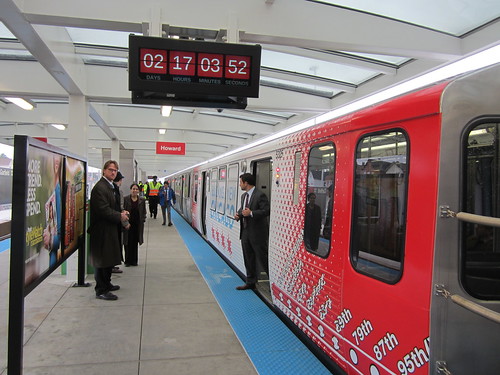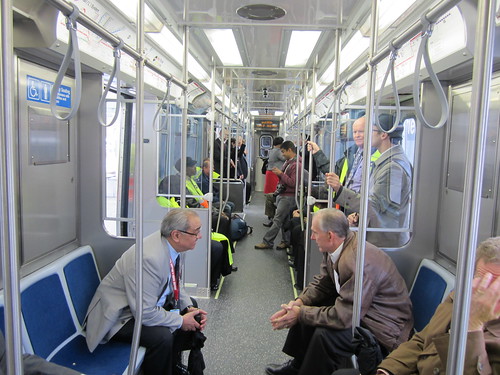At a time when the CTA has been coming under fire for the glitchy launch of the Ventra farecard system, today’s ribbon cutting for the Red Line Reconstruction project was a well-earned celebration for the transit agency, and a love fest for local politicians.
Many residents and journalists originally questioned the plan to completely shut down the line for five months to rebuild 10.2 miles of track, a stretch that was roughly 40 percent slow zones. But after the project started, it was widely acknowledged that the CTA had done a solid job of providing alternative service. These measures included rerouting Red Line trains to run on Green Line tracks through the South Side, and adding frequent shuttle bus service between the Garfield Green stop and shuttered Red Line stations further south.
Now that the $425 million reconstruction is complete, with service launching this Sunday, the CTA says riders will save 20 minutes on the roundtrip from 95th Street to Roosevelt Road. Eight stations, from Cermak/Chinatown to 87th Street, received new lighting, paint and Train Tracker screens, and Garfied, 63rd Street and 87th got new elevators, which means the entire south Red Line is now wheelchair accessible. 95th Street is slated for a full $240 million reconstruction next year.
The city says the benefits for South Siders also included the creation of over 1,500 jobs during the construction project, with 400 bus drivers hired to operate the shuttles and other additional bus service during the shutdown. The drivers will continue to work at the CTA, and some of the construction workers from the project were permanently hired by the contractors and subcontractors. 29 percent of the track work and 40 percent of the station work was done by disadvantage business enterprise firms, with over $56.4 million going to African-American contractors.
At the Red Line celebration this morning at the Garfield Station, the podium was surrounded by South Side aldermen, congressmen and state reps. CTA Board President Terry Peterson took the microphone first. “Thanks to Governor [Pat] Quinn’s Illinois Jobs Now program and the visionary leadership of Mayor Emanuel, a new railroad has been built on Chicago’s South Side, and the people standing before you could not be more proud,” he said.
CTA President Forrest Claypool said he was pleased that the five-month shutdown caused relatively little inconvenience for riders. “There were many voices that predicted that the project would lead to chaos and confusion, that there was no way to move tens of thousands of [Red Line riders] on other trains and shuttle buses,” he said. “Starting from Day One, the feedback we received from the riders indicated the opposite.”
“We’ve heard from a number of riders who said that the shuttle buses were faster than their old Red Line trains, something that really illustrates how badly this project was needed,” he added. “To those customers I say, ‘If you think the shuttle buses were fast, wait until you ride the new Red Line.’”
Governor Pat Quinn lauded the project as an outstanding achievement. “I think if Harold Washington was here today, he’d say we knocked the damn door down,” he said. “You ain’t seen nothing yet. We have to work on public transit for the CTA and Metra and Pace all across our region, northeastern Illinois. It’s very important we have a 21st Century transportation system.” These were encouraging words from the governor, but it’s worth noting that he has recently been pushing hard for the $2.75 billion Illiana Tollway, a decidedly 20th Century project that would compete with transit projects for limited transportation funds.
Mayor Rahm Emanuel noted that the south Red Line hasn’t been overhauled since it was built in 1969, back when Richard Nixon was president and Neil Armstrong walked on the moon. “We had to actually take a holistic approach and go whole-hog to fix this one and ensure that people on the South Side of Chicago were not watching bikes passing by because they were in a 10 mph zone on the train,” he said. “You know [the rehab] was successful, because if it wasn’t on time and on budget it would be Terry, Forrest and me here alone today.”
Speaking in the wake of the recently resolved government shutdown, U.S. Senator Dick Durbin said the dysfunction in Washington stands in stark contrast to the collaboration that resulted in the new south Red Line. “What we have been through as a nation these last two weeks really comes home right here at the Garfield Station,” he said. “We should not be denying the services of government. We ought to be making those services more efficient and more responsive, so that the taxpayers believe that their money is invested in things that serve, that create a better quality of life, and create jobs, and I’m looking at one right here.”
Afterwards the press was invited to take a test run on the freshly laid tracks. I boarded a brand-new, New York City-style 5000 Series car with baby-blue seats and wall trim, and the train took off at a surprisingly fast pace, perhaps comparable to the Evanston Express before it was hobbled by slow zones. 380,000,000 pounds of new ballast and 7,797,460 pounds of new rail were used in the rehab, resulting in a smooth ride. Traveling nonstop, we covered the four miles between Garfield and Cermak in nine minutes – that’s almost 27 mph. By the time the pagoda-like structures of Chinatown came into view, it was clear that this faster, more comfortable service was worth the wait.








